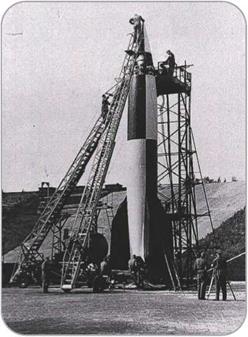Missile
|
M |
issiles are self-propelled weapons that fly toward their targets at high speed, armed with an exploding warhead. There are many different types of missiles.
The Basic Types
Small missiles are used for attacking targets, such as tanks, just a few hundred or thousand feet away. These small battlefield missiles used by armies are also called tactical missiles. There also are longer-range missiles carried by ships and helicopters for attacking enemy ships, aircraft, and land targets. The biggest and most powerful missiles can fly thousands of miles and do enormous damage to a whole city. These missiles are known as strategic missiles.
Nearly all missiles have a guidance system that steers them toward their targets. For this reason, they are called
guided missiles. There are different types of guidance systems. Some use the heat of the target (for example, the heat generated by the jet exhaust of an enemy fighter plane). Other guidance systems are radar seeking, using the radar reflection of an oncoming missile to find and destroy it. Missiles aimed at a stationary target on the ground can use GPS as their guidance system.
Missiles also are defined by where they are fired from and what their target is. Surface-to-air missiles (SAMs) are launched from the ground at aircraft. Air-to-ground missiles (AGMs) or air-to – surface missiles (ASMs) are fired by aircraft at targets on the ground.
Air-to-air missiles (AAMs) are fired by aircraft at other aircraft. The AIM-9 Sidewinder is a short-range missile used by fighter planes in combat with each other. AIM stands for air intercept missile. When a Sidewinder is fired, its solid fuel rocket accelerates it to more than twice the speed of sound. Fins on the nose and tail provide lift and steer the missile. The missile’s nose
О A view of the wing of a U. S. Navy Hornet shows two laser-guided bombs and (on the outside) an AIM-9 Sidewinder missile. The Sidewinder is an air – to-air missile, which means it is used by aircraft to attack enemy aircraft.
![]()
|
![]()
The world’s first ballistic missile was the V-2, developed in Germany during World War II. It stood 47 feet (14 meters) high and weighed about 29,100 pounds (13,200 kilograms). The V-2’s nose contained 1,600 pounds (about 725 kilograms) of explosives. Its rocket
 engine, burning alcohol and liquid oxygen, boosted it to a height of about 50 miles (80 kilometers), and then the V-2 fell toward its target, up to 200 miles (320 kilometers) away. The V-2 arrived without warning because it flew faster than the speed of sound. Even if a V-2 was spotted, it was flying too fast to be shot down.
engine, burning alcohol and liquid oxygen, boosted it to a height of about 50 miles (80 kilometers), and then the V-2 fell toward its target, up to 200 miles (320 kilometers) away. The V-2 arrived without warning because it flew faster than the speed of sound. Even if a V-2 was spotted, it was flying too fast to be shot down.
The V-2 was not a very accurate weapon. It could be fired at something as big as a city with a good chance of hitting it, but it could not be counted on to hit smaller targets, such as bridges or runways. About 4,000 V-2s were launched during the war-more than 1,000 fell on London. After the war, the United States and the Soviet Union captured scores of unused V-2 rockets. Many of the ballistic missiles and space rockets built in the 1950s were based on the V-2.
![]() О A V-2 rocket is prepared for launch by technicians in Germany in the early 1940s.
О A V-2 rocket is prepared for launch by technicians in Germany in the early 1940s.
4___________________________________ _________________________________________
contains an infrared (heat) seeker. This detects the heat of the target plane and steers the missile toward it.










